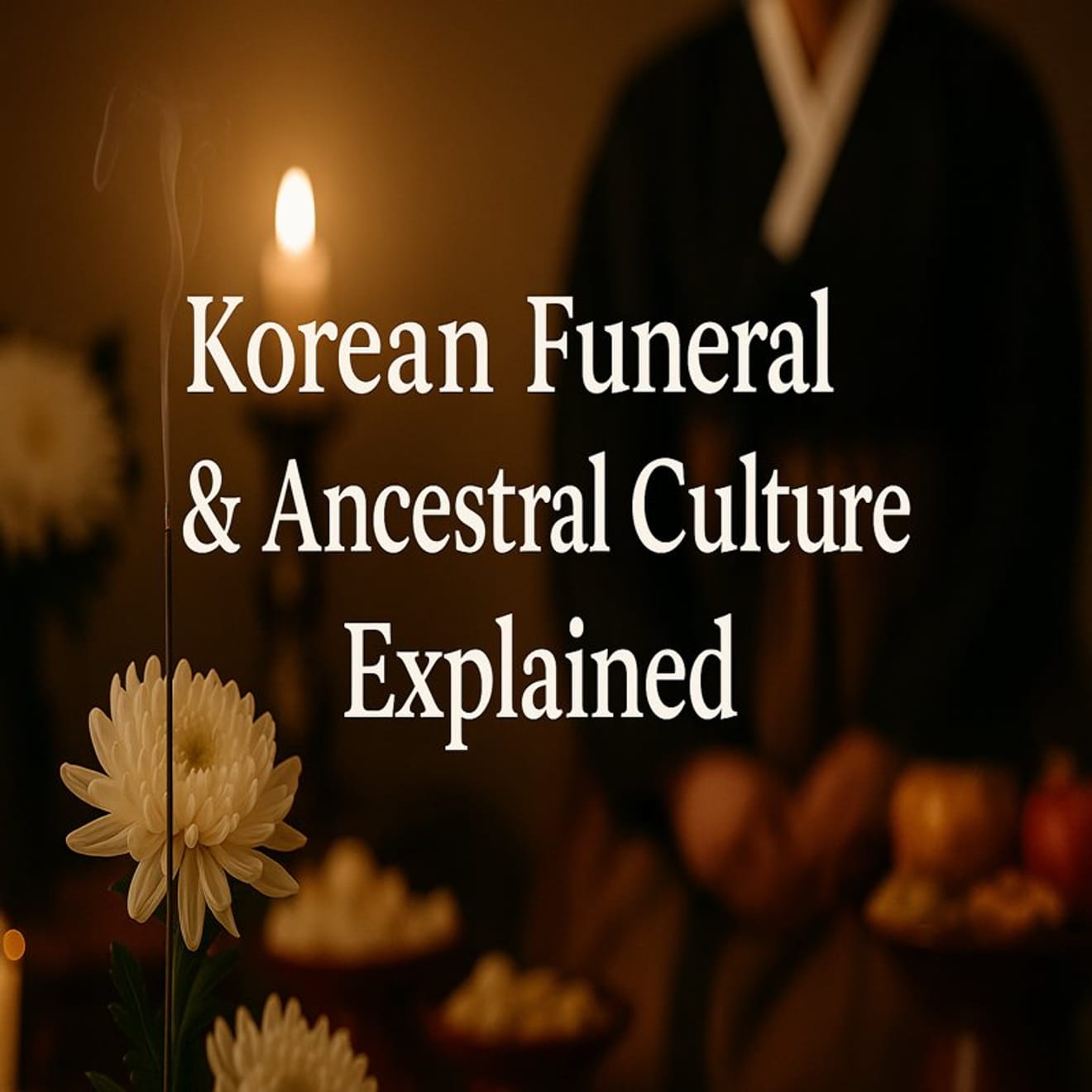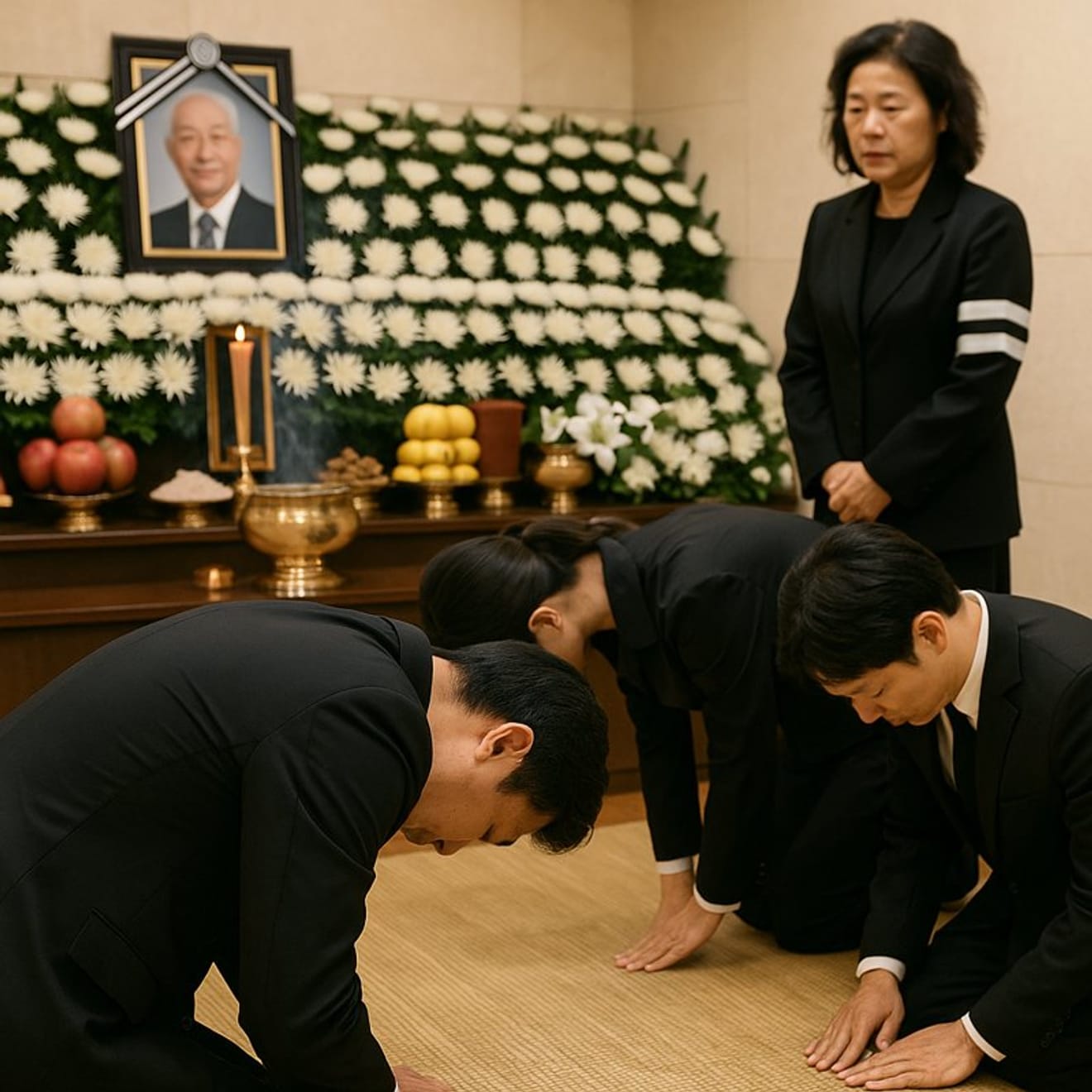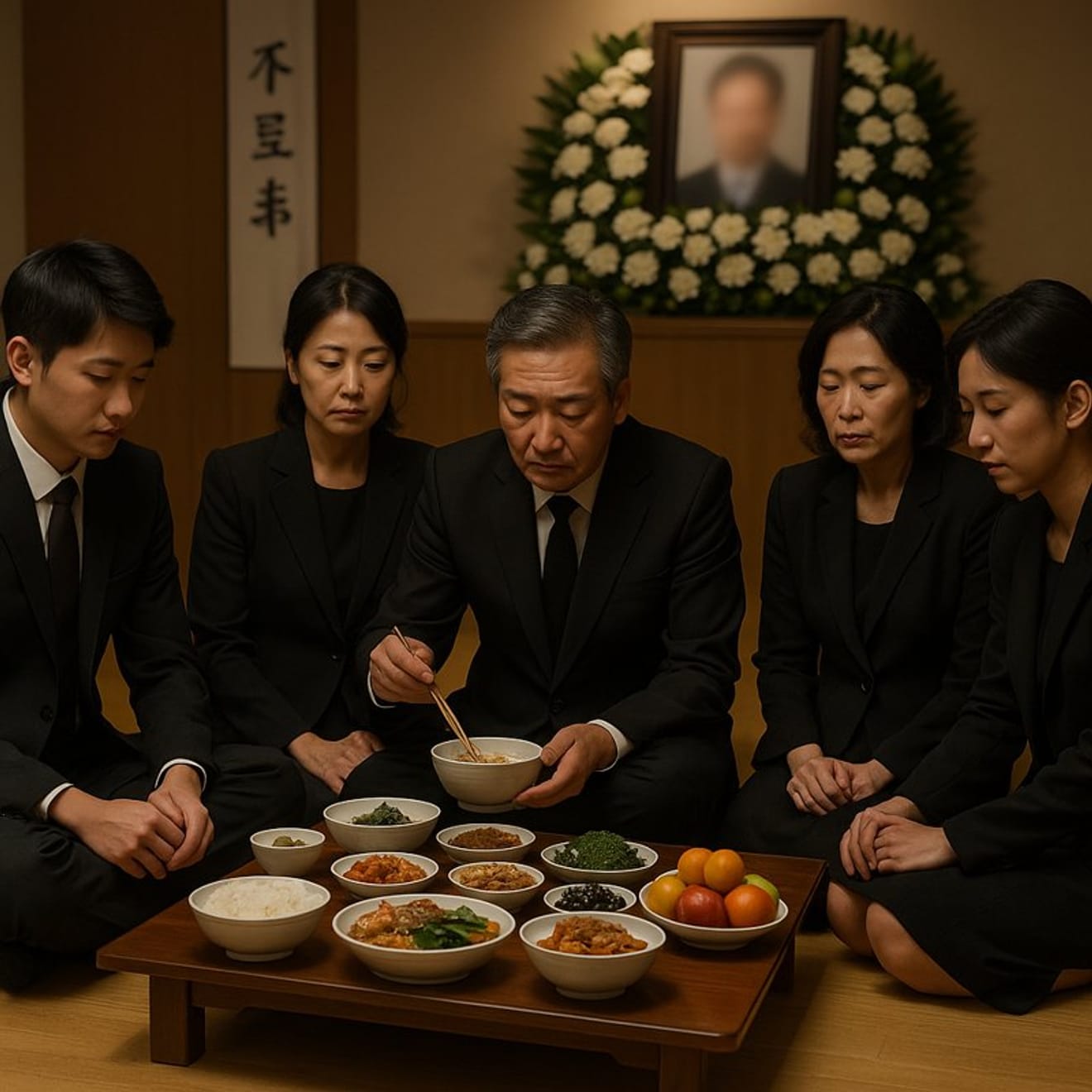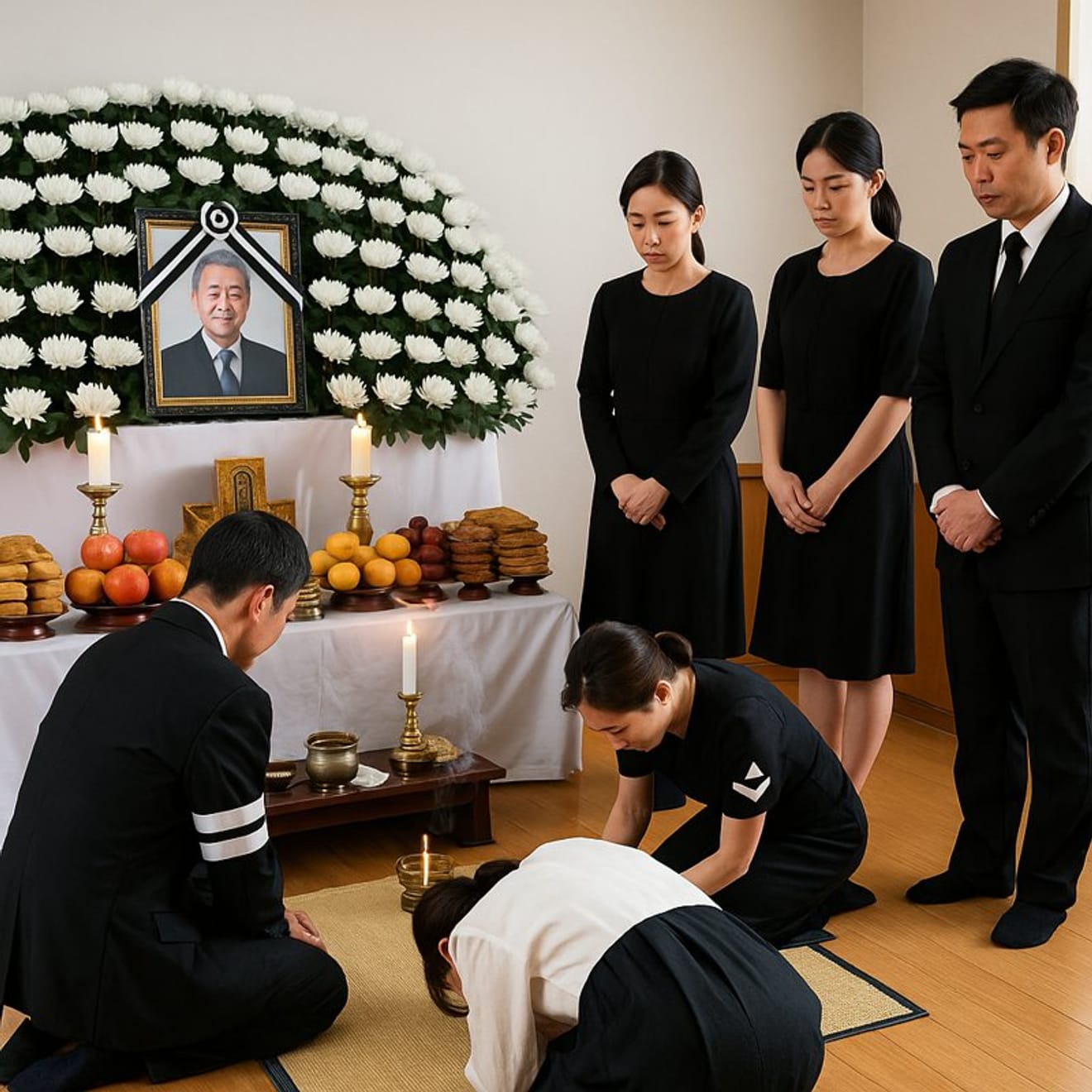Subject
- #Condolences
- #Ancestral Rites Culture
- #Korean Funeral Culture
- #Funeral Etiquette
- #Condolence Money
Created: 2025-05-10
Created: 2025-05-10 15:43
If you travel or live in Korea, there are times when you might be taken aback by an unfamiliar scene unfolding before your eyes. People dressed in neat black and white attire quietly lining up to bow, and staying in a certain space while burning incense. This is the ‘Korean funeral home’.

6 Korean Funeral Cultures: Traditions and Etiquette Foreigners Must Know
Despite being a rapidly modernizing country, Korea still strongly cherishes the tradition of valuing ties with ancestors. And the moments when that tradition is most strongly revealed are funerals and ancestral rites culture. From the way grief is shared, the attitude of condolence, to the etiquette of setting up the ancestral table—all of these contain Korea's unique values.
Many foreigners have become familiar with Korean food culture, Hanbok, and K-pop, but they often find it difficult to deeply understand funeral culture or ancestral rites culture. Perhaps it might feel cautious and unfamiliar when first encountered. But for that very reason, this topic can be the most impressive and unique experience for foreigners interested in Korean culture.
• Why do Koreans bow at funerals?
• Why is the food on the ancestral table so neatly arranged?
• How should foreigners behave when attending a funeral?
• Is the ancestral rite related to religion?
For foreigners with these questions, this article will be a guide to deeply understand Korean culture, not just a simple introduction of information.
Shall we find out together now? The way Koreans view life and death, and the traditions, etiquette, and the meaning of family contained within.

6 Korean Funeral Cultures
A funeral in Korea is not a mere ritual, but an important social event to commemorate the deceased and confirm the bond between family members. Most Korean funerals are conducted in the traditional format of "3-day funeral", and the funeral procedures continue for 3 days after the death.
• Day 1: The deceased's body is placed in the funeral home, and the Sangju (family) prepares to receive condolence visitors.
• Day 2: Greeting condolence visitors, and according to the religion, Catholic mass, Buddhist ceremony, or traditional ancestral rites may be held.
• Day 3: The day of departure, the deceased's body is transferred to the burial site or crematorium, and the final procedures of the funeral are carried out.
The core of a Korean funeral is "respect and etiquette." All attendees express their hearts to commemorate the deceased in a quiet and restrained atmosphere.
Condolences at a Korean funeral home have a meaning beyond a simple greeting. Through condolences, you commemorate the deceased and convey your condolences to the bereaved family.
• Entry: Condolence visitors write their names in the visitor's book upon entering the funeral home.
• Offering flowers or incense: Offer flowers or burn incense in front of the deceased to pay respects.
• Bow: Generally, bowing twice is traditional, and bowing once to the bereaved family to greet them.
For foreign condolence visitors, if bowing feels awkward, bowing your head or just offering flowers is considered respectful enough.
• Attire: Wear neat black or dark gray clothing. Shorts or revealing clothing should be avoided.
These etiquettes are not just formalities, but important elements that reflect the culture of respect and courtesy of Koreans.

6 Korean Funeral Cultures
One of the unique parts of a Korean funeral is the meal provided to the condolence visitors. By providing a warm meal to those gathered in a place of sorrow, the bereaved family expresses their gratitude.
• Foods commonly provided: Beef and radish soup, japchae, jeon (Korean pancake), various side dishes, bulgogi, and fruits are common.
• Meaning: These foods commemorate the deceased, comfort the hearts of the condolence visitors, and also play a role in demonstrating the solidarity of the community.
• Etiquette: When receiving food, it is polite to silently express gratitude and eat as much as possible without leaving any leftovers.
As such, food is not merely about filling the stomach, but has become a symbolic act of sharing each other's hearts.
Ancestral rites are an important family rite in Korea to express respect and gratitude to ancestors. Especially on Seollal (Lunar New Year's Day), Chuseok (Korean Thanksgiving Day), and gijeol (ancestral memorial day), families gather to prepare food for their ancestors and bow.
• Composition of the ancestral table: Various foods such as rice, soup, jeon, fruits, meat, and fish are prepared according to fixed rules. Even the order and direction of the food placement are considered important.
• Flow of the ritual: Burning incense → Heonjak (offering liquor) → Bow → Reading the eulogy → Eumbok (eating together with family after the rite)
• Meaning: Beyond a traditional rite, it is a time to remember the roots of the family and strengthen the bond.
Nowadays, there are cases where it is simplified or omitted for religious reasons, but it is still being carried out in many households.
Although it may be complex and unfamiliar to foreigners, ancestral rites are a symbolic rite that well demonstrates the Korean culture of respecting ancestors and Confucian traditions.
It is important to understand the background and meaning of Korean funerals and ancestral rites culture, rather than simply following them. The following are tips that foreign visitors should know:
• When bowing feels burdensome, it is enough to bow your head silently.
• Dress as modestly and neatly as possible—a white shirt and black pants are a safe choice.
• If invited to an ancestral rite, you can eat the food silently and follow the atmosphere quietly.
• Photography is prohibited, as funerals and ancestral rites are private ceremonies, it is polite not to take photos without permission.
• The most important thing is a cautious attitude. It is good to have an open mind of "this culture is new to me" before any action.
This attitude goes beyond the level of etiquette and greatly helps in building deeper trust with Koreans.
When attending a Korean funeral, most people give money in an envelope called "Jo'uigeum (condolence money)." This is a practical expression of mourning for the deceased and at the same time helping the bereaved family.
• Form: Generally, cash is put in a white envelope, and "Bu'ui(賻儀)" or "Jo'ui" is written on the outside of the envelope.
• Amount: The closer the relationship, the more money is given, and generally, 30,000 won, 50,000 won, or 100,000 won are common amounts. Foreigners can freely choose an amount that they do not feel burdened with.
• How to give: Write your name in the visitor's book at the reception desk set up at the funeral home and hand over the condolence money. You do not need to say a separate greeting at this time.
• Meaning: Condolence money is not just money, but a symbol of consolation for the bereaved family and sharing the sorrow together within the community.
Although it may be an unfamiliar culture for foreigners, this condolence money culture is an important element that shows the Jeong (情) and bonds of Korean society.

6 Korean Funeral Cultures
Korea is a rapidly modernizing society, but the respect for tradition and family-centered values are still strongly maintained within it. Especially, funeral and ancestral rites culture are rituals that most clearly reveal the sentiments of Koreans. From the last farewell to the deceased to the etiquette of condolence, and every single neatly arranged dish on the ancestral table—in all those processes, the respect for ancestors (禮), the sharing of sorrow within the community (情), and consideration for the remaining people are deeply embedded.
From the perspective of foreigners who encounter this culture for the first time, the format may feel complicated, or the actions such as bowing or giving condolence money may not be understood. However, behind it, is a way of ‘respecting people’that Korean society has maintained for a long time. Condolences are not just greetings or formalities, but are practical etiquette that remembers the life of the deceased and conveys the feelings to the bereaved family, and ancestral rites are not just rituals, but a time to carry on the roots and traditions of the family.
This article is not just for introducing Korean culture, but is written to help you understand the culture and have a respectful point of view. If you ever experience this culture directly in Korea, the knowledge and mindset learned through this article will make you a warmer and more mature visitor.
It's not just elements that receive global attention, like K-pop or dramas, in Korea. These detailed but meaningful traditions are also precious cultural assets that make Korea even more special.
Comments0